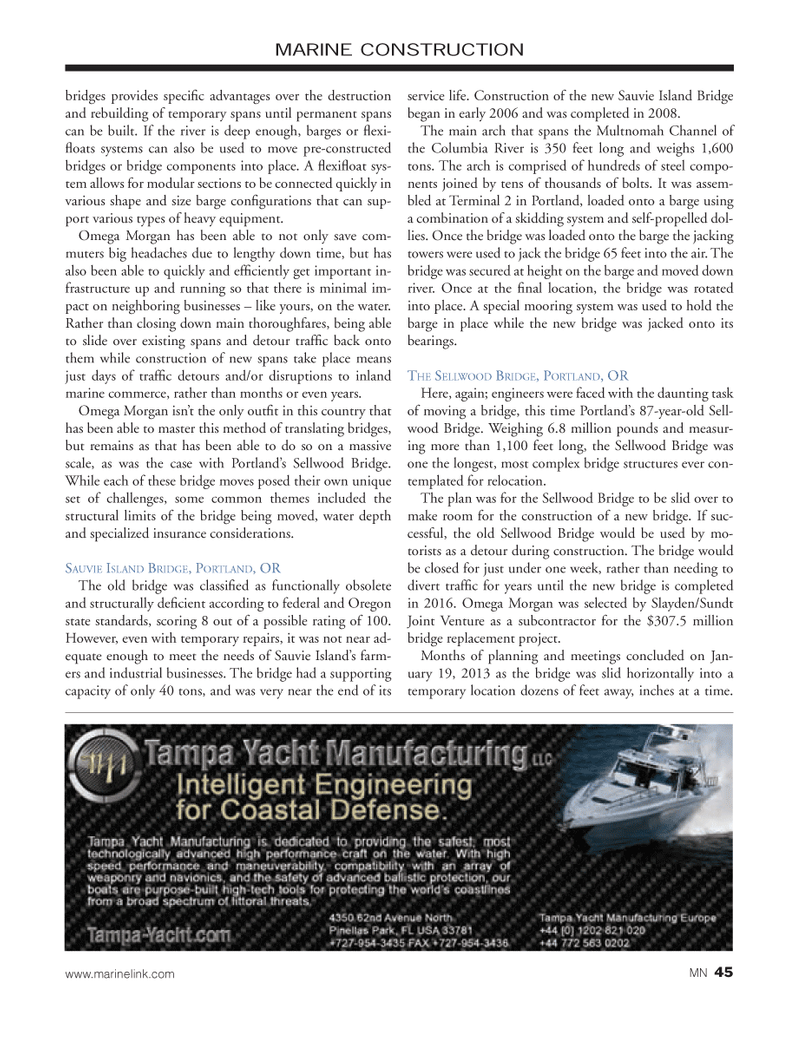
Page 45: of Marine News Magazine (December 2013)
Innovative Products & Boats of 2012
Read this page in Pdf, Flash or Html5 edition of December 2013 Marine News Magazine
bridges provides speciÞ c advantages over the destruction and rebuilding of temporary spans until permanent spans can be built. If the river is deep enough, barges or ß exi-ß oats systems can also be used to move pre-constructed bridges or bridge components into place. A ß exiß oat sys- tem allows for modular sections to be connected quickly in various shape and size barge conÞ gurations that can sup- port various types of heavy equipment. Omega Morgan has been able to not only save com- muters big headaches due to lengthy down time, but has also been able to quickly and efÞ ciently get important in- frastructure up and running so that there is minimal im- pact on neighboring businesses Ð like yours, on the water. Rather than closing down main thoroughfares, being able to slide over existing spans and detour trafÞ c back onto them while construction of new spans take place means just days of trafÞ c detours and/or disruptions to inland marine commerce, rather than months or even years. Omega Morgan isnÕt the only outÞ t in this country that has been able to master this method of translating bridges, but remains as that has been able to do so on a massive scale, as was the case with PortlandÕs Sellwood Bridge. While each of these bridge moves posed their own unique set of challenges, some common themes included the structural limits of the bridge being moved, water depth and specialized insurance considerations. SAUVIE ISLAND BRIDGE, PORTLAND , ORThe old bridge was classiÞ ed as functionally obsolete and structurally deÞ cient according to federal and Oregon state standards, scoring 8 out of a possible rating of 100. However, even with temporary repairs, it was not near ad- equate enough to meet the needs of Sauvie IslandÕs farm- ers and industrial businesses. The bridge had a supporting capacity of only 40 tons, and was very near the end of its service life. Construction of the new Sauvie Island Bridge began in early 2006 and was completed in 2008.The main arch that spans the Multnomah Channel of the Columbia River is 350 feet long and weighs 1,600 tons. The arch is comprised of hundreds of steel compo- nents joined by tens of thousands of bolts. It was assem- bled at Terminal 2 in Portland, loaded onto a barge using a combination of a skidding system and self-propelled dol- lies. Once the bridge was loaded onto the barge the jacking towers were used to jack the bridge 65 feet into the air. The bridge was secured at height on the barge and moved down river. Once at the Þ nal location, the bridge was rotated into place. A special mooring system was used to hold the barge in place while the new bridge was jacked onto its bearings.THE SELLWOOD BRIDGE, PORTLAND , ORHere, again; engineers were faced with the daunting task of moving a bridge, this time P ortlandÕs 87-year-old Sell- wood Bridge. Weighing 6.8 million pounds and measur- ing more than 1,100 feet long, the Sellwood Bridge was one the longest, most complex bridge structures ever con- templated for relocation. The plan was for the Sellwood Bridge to be slid over to make room for the construction of a new bridge. If suc- cessful, the old Sellwood Bridge would be used by mo- torists as a detour during construction. The bridge would be closed for just under one week, rather than needing to divert trafÞ c for years until the new bridge is completed in 2016. Omega Morgan was selected by Slayden/Sundt Joint Venture as a subcontractor for the $307.5 million bridge replacement project. Months of planning and meetings concluded on Jan- uary 19, 2013 as the bridge was slid horizontally into a temporary location dozens of feet away, inches at a time. MARINE CONSTRUCTIONwww.marinelink.com MN 45MN Dec2013 Layout 32-49.indd 45MN Dec2013 Layout 32-49.indd 4511/25/2013 12:51:47 PM11/25/2013 12:51:47 PM

 44
44

 46
46
